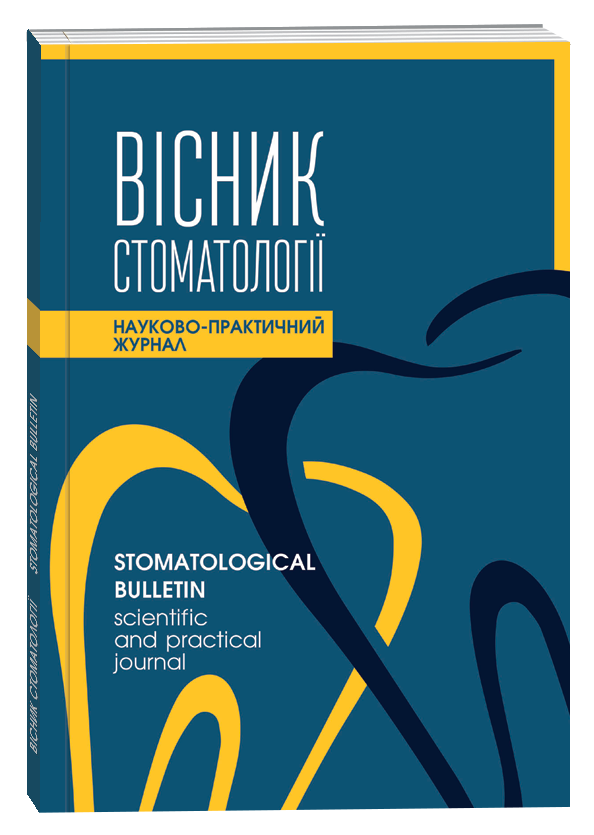AESTHETIC RESTORATION OF TEETH WITH PRECERVICAL LESIONS
DOI:
https://doi.org/10.35220/2078-8916-2020-36-2-44-48Keywords:
dental caries, precervical lesions, direct res-toration, nanophotocomposite, glass ionomer cementAbstract
The purpose of the study. Clinical evaluation of the di-rect restorations made of different restoration materials of teeth with precervical carious lesions with different approaches to the preparation of cavities.
Materials and methods. The study involved 118 people aged 20 to 42 years old with precervical carious lesions of posterior teeth. In patients of groups 1 and 3, cavities were prepared according to generally accepted require-ments. In persons of group 2, additional conditions for re-tention were created in the dentin of the gingival wall. Di-rect reconstructions in patients of groups 1 and 2 were performed from nanophotocomposite, in patients of group 3 - from glass ionomer cement. The condition of the restorations was evaluated by clinical and aesthetic criteria at 12 and 24 months.
Results and discussion. For two years of follow-up, the largest number of missing restorations and cases of sec-ondary caries was found in patients of group 1. Aesthetic disorders most often occurred in patients of group 3. Ad-ditional conditions for retention provided high clinical rates of direct precervical photocomposite restorations in patients of group 2.
References
Борисенко А. В. Композиционные пломбировоч-ные и облицовочные материалы / А. В. Борисенко, В. П. Не-спрядько, Д. А. Борисенко // Медицина. – К.: ВСИ «Меди-цина», 2015. – 320 с.
Maan M. AlShaafi. Factors affecting polymerization of resin-based composites: A literature review / Maan M. AlShaafi // Saudi Dental Journal. – 2017. – Vol. 29 (2). – P. 48–58.
Радлинский С. В. Полимеризационный стресс в объемных реставрациях / С. В. Радлинский // Современная стоматология. – 2010. – № 4. – С. 34-39. 4. Луцкая И. К. Полимеризационная усадка: методы дрессуры и минимизация последствий / И. К. Луцкая // СтоматологИнфо. – 2013. – № 1. – С. 24–27.
Hanan Al Sunbul. Polymerization shrinkage kinetics and shrinkage-stress in dental resin-composites / Hanan Al Sunbul, Nick Silikas, David C Watts // Dent Mater. – 2016. – Vol. 32(8). – Р. 998-1006.
Порівняльна характеристика стану реставрацій клиноподібних дефектів зубів після механічного наванта-ження / Н. М. Браїлко, І. Я. Марченко, В. І Макаренко [та ін.] // Актуальні проблеми сучасної медицини: Вісник укра-їнської медичної стоматологічної академії. – 2015. – Том 15, Випуск 1 (49). – С. 153-155.
Ярова С. П. Диференційований підхід до оперативного лікування пришийкових уражень твердих тканин зу-бів / С. П. Ярова, І. І. Заболотна // Новини стоматології. – 2017. – № 3. – С. 84-87.
Удод О. А. Клінічне дослідження стану приший-кових відновлень зубів / Удод О. А., Афоніна В. В. // Вісник проблем біології і медицини. – 2019. – Вип. 2, Том 1 (150). – С. 324-327.
Николаев А. И. Практическая терапевтическая стоматология : учеб. пособие / А. И. Николаев, Л. М. Цепов – [9-е изд.] – М.: МЕДпресс-информ, 2017. – 928 с.
Ryge G. Клинические критерии / G. Ryge // Кли-ническая стоматология. – 1998. – № 3. – С. 40–46.









